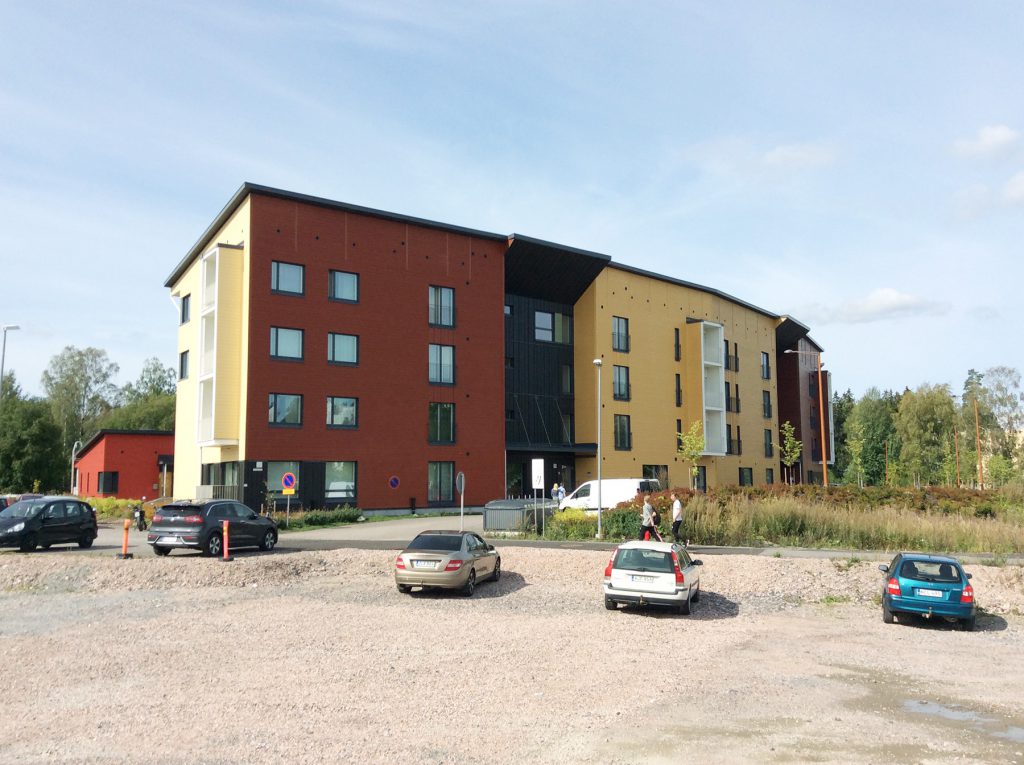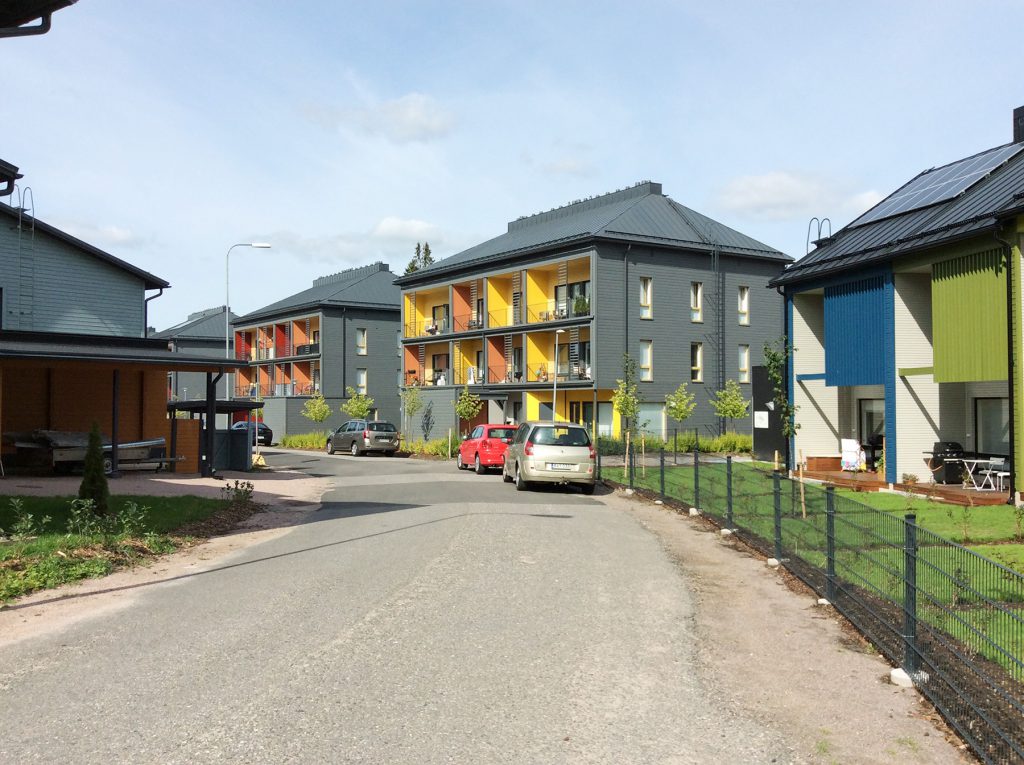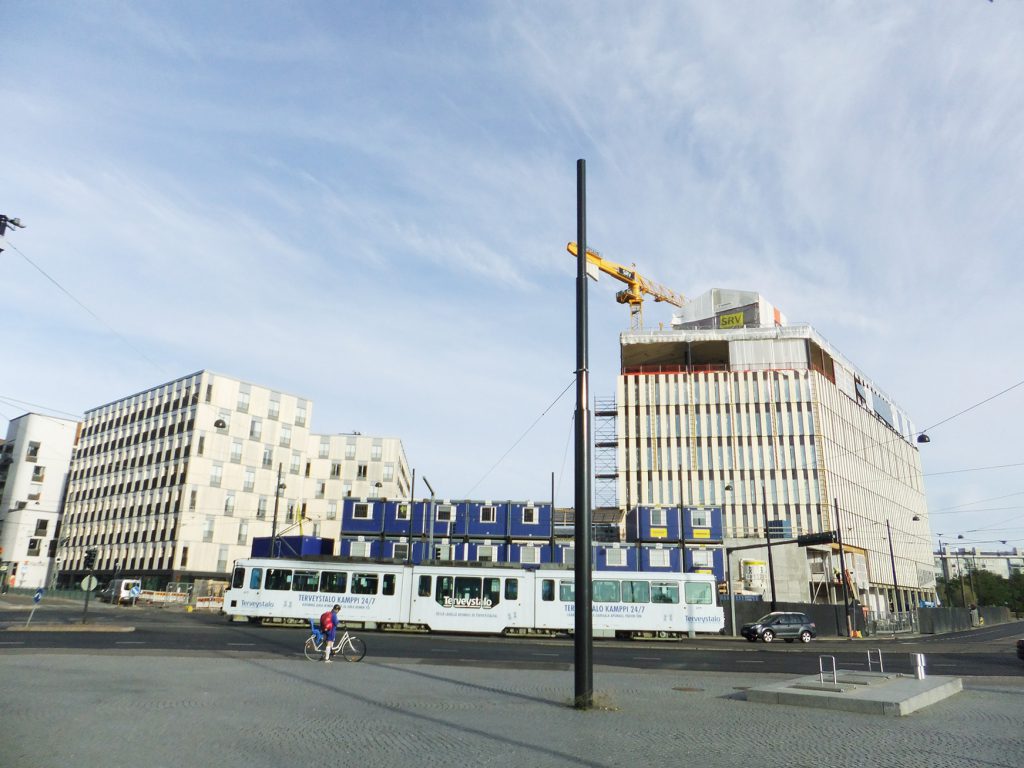北欧の国・フィンランドは世界一の森林率を誇る森と湖の国。日本もスウェーデンに続き、世界3番目の森林大国ですが、フィンランドと日本の「キノマチ度」は大きく違いがあります。
森林そのものが社会課題になっている日本と比べ、フィンランドは木材・林業が国の主要産業であり、私有地の木であっても樹齢70年以下は伐採を禁じるなど森林の生態系を守るための厳しい法整備がなされています。また国民は「自然享受権」という、自然の恵みを誰もが楽しむ権利が認められています。
フィンランドの人が生きるうえで欠かせない「森林」「木」をめぐる林業・木材産業、そして木造・木質建築について、現地からの目線で語っていただき、日本で実現したい「キノマチ」のヒントを見つけたいと思います。

Petri Heino(ペトリ・ヘイノ)
フィンランド政府環境省全国木造建築プログラムマネージャー。2000年にフィンランド森林林業工業連合マネージャー、2011年にキュメンラークソ応用科学大学研究マネージャー、2016年より現職。
1995 Master of Science in Marketing, University of Helsinki
2000 Manager, the Finnish Forest Industries Federation
2011 Research Manager, Kymenlaakso University of Applied Sciences
2016-present Manager of National Wood Building Program at the Ministry of the Environment of Finland
イントロダクション
木材は数ある建築資材の中でも最も古くから使われている素材として知られています。また、木材の入手のしやすさが、各地域の建築構法や施工方法を特徴づけてきました。北方の亜寒帯・針葉樹林気候帯にあるフィンランドは、特に、木で建てられた国ともいえます。
フィンランドの林業の歴史
木から採取されるタールの輸出や、水路沿いに建てられた小規模な製材所の時代を経て、フィンランドは19世紀後半に森林の大規模な開発を始めました。当時、製紙工場と製材工場の両方が経営者に利益をもたらすこととなり、また同時に労働者の生活までも潤すことになっていました。フィンランドの内戦とソ連との断続的な戦争が決着したわずか60年前には、森林産業の成長が確実視されはじめていました。現在のフィンランドの福祉国家としての発展は、森林産業の成功によるものです。

終戦後は、工場で生産された工業住宅の生産の技術開発が盛んに進められました。その結果として、フィンランドでは大規模な工業住宅の輸出が行われるようになったことに加え、特にフィンランド国内で戸建て住宅を望む家族層への住宅産業が特に強く押し進められました。
1980年代初頭、フィンランド国内産業の国際化への圧力や、パルプ・製紙産業での生産の方向転換、幅広い新規投資の必要性から森林産業は激しい構造転換が引き起こされることになりました。その結果、巨大な国際林業企業が誕生することになります。
それと同時に、木材産業は様々な市場の顧客にとって既にブランド化されていて、高品質の北欧産針葉樹製材に注力していました。ゆっくりと成長することで、まっすぐな木目で高い強度を有するスプルースとマツは、集成材の材料として、また、エンドユーザーの求める見た目の美しさにも適しています。
2000年代には、紙の需要が激減し、世界的な不況もあって木材の需要は減少しました。世界的な不況からの回復期においても、森林産業は好転することはありませんでした。森林産業の不況からの脱出はそう簡単なことではありませんでした。
しかし、どのような経済状況であれ、森林産業部門はフィンランドの持続可能な開発を推進する上で重要な役割を果たしています。
現在進行している森林産業の構造変化は、既存の製品の改善だけでなく、森林資源と木材を根底においた新しいバイオ製品とエネルギーソリューションの開発にも焦点を当てています。木材はそのライフサイクルを通じて長い期間にわたり炭素固定を行い、使用するにあたりエネルギーの消費を抑制し、また再生可能な建設資材であることから、特に建設分野における木材需要が大きく成長すると期待されています。
森林には単なる木材の価格以上に資源としての価値があり、これは私たちが森林を考える上でますます重要になってきています。
フィンランドにおける木造建築の広まり
1990年以降、木材を用いた建築物は、様々な政策・プログラムやアクションプランによって推進されてきました。
the Wood in Construction Technology Programme (1995-1998)
the Year of Wood (1996)、the Time of Wood (1997-2000)
Wood Finland (1998-2005)、Wood Construction (2000)
the Programme for Promotion of Wood Construction (2004-2010)
the Strategic Programme for the Forest Sector (2011-2015)
the National Forest Programme (2015)
the Rural Development Programme for Mainland Finland
以上のプログラムなどが例として挙げられます。
2016年以降、フィンランドの環境省は「The Finnish Wood Building Program」に着手しました。産業に関する技術基盤の強化や木造の建設工事に関連する法律や建築規制の改正、木造の建設工事に関して根拠に基づいた情報の提供などにより説得力のある木材の利用法を普及・促進します。このプログラムの最終目標は、木造の建設工事をフィンランドの建設産業の不可欠な一面として定着させることです。
建築に関する規制の視点から、フィンランドの建築に関する法律は大規模な従来の建築物と比較して木造建築物の欠点を減らすために、これまで20年間かけて段階的に改正されてきました。2025年に計画されているLCA評価の建築規制への導入は、特に木材のCO2貯蔵能力を積極的に取り入れられることとなり、木造建築の普及で最も良い影響を及ぼすものと思われます。
地域行政の視点から、都市の計画やゾーニング、地域指定に関する政策の運用が大きな成果を生むことになります。しかし一方で、さらなる困難な問題を克服する必要もあります。過去に、自治体が公共入札で木材利用を要求した際、しばしば訴訟となることがありました。
公共入札で木材を利用していく政策は、主にセメント業界から自由競争法への干渉を理由に批判されることになりました。しかしヘルシンキ市がホンカスオ近隣地区を木造建築とすることに対して合法とした2015年の裁判所の判決をもとに、このような批判を退けることができるようになるかもしれません。ただ、この裁判所の判決は、他の自治体に行動を促すこととなりました。例えば、ミュッリュプロ などの都市開発プロジェクトでは木材による建材利用が義務付けられました。


アアルト大学やヘルシンキ総合大学、東フィンランド総合大学、オウル総合大学と タンペレ総合大学があります。主な資金提供者は政府の基金運営、投資を担う「ビジネス・フィンランド」という組織です。フィンランド森林研究所、フィンランド環境研究所、フィンランド労働衛生研究所、フィンランド技術研究センターで、木材の材料特性や利用方法、木造の建設工事について研究されています。また、2021年からアアルト大学建築学部に木材建築学科が設置される予定です。
森林と林業、建設産業、都市における木材利用のつながり〜ウッドシティを例として〜
木造の建設分野で様々な利害関係者の幅広い協力関係による成功例があります。この協力関係は、森林と木材産業が認知度を高め、新たな市場を創出するための絶好の機会となりました。成長する高層建築や公共建築の市場は業界の注目を集めています。
ヤトゥカサーリのウッドシティプロジェクトは、木材産業の市場をリードする木材サプライヤーであるStora Enso社が建設会社であるSRV社との協力で、不動産会社と建設会社の役割を果たす組織によるものの一例です。この優れた事業体により、Stora EnsoはLVLによる木造フレームのハイブリッド構造の導入など、研究と開発、新しい構工法や製品のテストを行うことができました。工業技術を実践的に学べるショーケースプロジェクトを創出し、将来に向けた産業が進むべき道標となる木造建築の開発を目指していました。


もう1つの事例は、MetsäWood社の 「Prodlib」 プロジェクトです。このプロジェクトは木造の建設ソリューションと建築部材を提供するオープンソースのプラットフォームの確立に加えて、オープンに共有された革新技術を導入して、可能な限り簡単かつ簡便に使用できるようにすることで、設計者の作業を容易にすることを目的としています。それと同時に、木造建設部門においてMetsäWood社の地位を確立し、確固たるものにしました。MetsäWood社は、都市の建設で木材を使用する方法を見つけるために、世界中の建築家や学生と議論してきました。
戸建て住宅とレジャー向け別荘など、小さな規模の建築において、Kontio社はフィンランドの伝統的なログハウスに対し、技巧を凝らした製品による現代的な建築に発展させることに成功しました。融通の利く自動化された生産システムは、個別のユーザーニーズに応えるカスタムメイドのソリューションと効率的な製造・生産を同時に実現しています。
木造建築における新しいマーケットとトレンド
建設部門に影響を及ぼす、21世紀の最も重要なトレンドは、人口動態の変化と気候変動に代表される環境問題、デジタル化とグローバル化に駆り立てられる世界経済の複雑化に関連しています。国連のパリ協定と持続可能な開発目標 (SDGs) の気候関連の目標に沿ってカーボンニュートラルな未来を築くためには、持続可能なバイオエコノミーの確立が必要となります。
トレンド:SDGsとサーキュラーエコノミー
「持続可能な⽣産と消費に関する(SDGsゴール12)を達成するために、建設部門は、(ターゲット12.2)天然資源の効率的利用に向けて改善を進め、(ターゲット12.5)廃棄物を削減することができる重要な部門と考えられるべきです。
建物の使用段階におけるエネルギー効率が向上するにつれて、建物の資源効率を向上させるために、具体的なエネルギーと天然資源の相対的な関係性がますます重要になってきます。
資源循環の政策は、まず製品や部品の耐用年数を延ばし、次に使用済みになった時点で材料の、閉じた循環とすることを目的としています。これは、1つの製品寿命を超え、長期にわたって資源の質を維持し、資源の採取と廃棄物の発生を削減できる可能性があります。

木材は自然素材として再生可能であり、低エネルギープロセスを使用し、他の建築材料や再生可能な燃料の原料としてリサイクルでき、使用できない廃棄物をほとんど発生させません。それは炭素回収のための費用のかからない解決策となります。また、木材部門はカーボンニュートラルを実現できない他の経済部門とオフセットして利用できるため、他の材料の代わりにこの自然で再生可能な材料を使用することは有益となります。
トレンド:ESG投資(環境、社会、ガバナンス)
建物は多くの資源を消費し、私たちは建物の中で多くの時間を過ごします。これは非常に大きなチャンスです。また、環境負荷以外にも経済的なものがあります。
グリーンビルディング認証を受けた収益物件は、入居率が高くなったり、テナント満足度が向上したりすることがあり、その結果、リース期間が長くなったり、需要が増えたり、賃貸料が高くなったりします。研究によると、グリーンビルディング認証の建物は、価格プレミアム、デフォルト・リスクの低下、ボラティリティの低下、低い減価償却率の恩恵を享受しています。
トレンド:都市の再高密度化
経済的、社会的及び環境的側面の下で、社会的に受け入れられる生活空間を創出する圧力は大きなものとなります。都市の高密度化は、解放された地域を利用することで未開発の土地を保護し、景観の無秩序な広がりを防ぐことを目的としているため、前向きにとらえられます。
木造の建築は、都市部における持続可能な再高密度化のために、迅速かつ高品質で、特に既存のものと互換性のある解決策を提供します。建設現場の交通量も少なくする工期短縮と建設工事の高いプレファブ化、生態系の良いバランスなどが評価されます。
トレンド:ヒーリングアーキテクチャ
多くの報告書において、特にそれが自然を反映しているのであれば、静かでリラックスできる環境が、私たちの精神的および身体的健康に良い影響を与えることを示しています。
特に木材は交感神経系活性(SNS)を低下させるため、ひとの健康に良い影響を与えるといわれています。またSNSはストレス反応を引き起こします。血圧と心拍数を上昇させ、消化、回復、修復などの機能を阻害します。自然や木材製品に囲まれることで、これらの症状は軽減します。

まとめ
今、まさに私たちは木を活用する新しい時代を経験しています。公共建築や集合住宅などを木で建てることに大きな関心が集まっています。また、コスト競争力を上げ、ユーザーにとって使い勝手の良い建物をつくる方法として構造的な選択肢が発展してきています。
マス・ティンバー(大断面集成材・CLT・LVL等)やログ材の利活用が、設計施工プロセスを簡素化して瑕疵が起こる余地を少なくしているでしょう。また、プレファブ化は材料効率や短工期化では鍵となります。新しい建築的な特徴としては特に自由な形態の実現に見られます。
これまで培ってきたノウハウを広げていくためには、国際的な協力が必要なのは明らかです。また、協力は政府レベル、学術レベル、会社レベルなどいくつかのレベルで必要です。例えば、アアルト大学のウッドプログラムは、木造建築に興味をもつ世界中の建築学生を繋げる先駆的な役割を果たしています。
このプログラムは、各学生がウッドプログラムでの勉強を終えて自分の大学に戻った際にはR&Dでの協力を行う基盤にもなっています。
企画・編集:坂口大史(日本福祉大学)、山口一紀(Studio Moopy)、小林道和(竹中工務店)
(原文)
Introduction
Wood is the oldest building material known to man. Alongside with the availability of wood it remained characteristic of building practices of some areas. Situated in the cold northern coniferous climate zone, Finland is a country of building in wood.
The history of forest industry in Finland
Putting aside the centuries of tar export and small saw mills set up along the waterways, Finland began the large-scale exploitation of its forests in the late 19th century. By that time, both paper and saw mills were already creating profits for their owners, but also an increasingly comfortable livelihood for the workers. But only 60 year ago and after the Finnish civil war and the Continuation War with the Soviet Union, the real success of the forest industry started to have a clear visible impact. The development of the welfare state is linked to the triumph of the forest industry.
After the wars the development of prefabricated industrial home manufacturing was strongly pushed forward. This resulted in to large export activities and especially strong industry to serve the Finnish single-family home customers.
The pressures of internationalisation, a reorientation of production in the pulp and paper industry and an extensive need for new investments triggered an intense process of change in the field of forest industry in the early 1980s. This led to the creation of huge international forest industry corporations. At the same time the wood products industry was focusing on high-quality renown Nordic coniferous sawn wood, which has been a brand among customers in various markets. Slowly grown, straight grain and there for strong spruce and pine wood is suitable for glulam production and for end-uses of high visual quality needs.
During the 2000s, the demand for paper shrank dramatically, and the global recession reduced demand for lumber. There was talk of a depression in the forest industry, even of its end. But this was not the case.
But whatever the economic situation, the forest sector is a key player in promoting sustainable development in Finland. The ongoing structural change in the forest industry focuses not only on improving existing products but also on developing new bioproducts and energy solutions based on forest resources and wood. In the wood product industry, the use of wood in construction in particular is expected to be a significant growth area, since wood is a low-energy, renewable construction material throughout its life cycle while providing long-term carbon sequestration.
The forest has more value than just the price of its lumber, and this is an increasingly important, even vital, part of the way we think about forests.
The spread of wood architecture Finland
Building with wood has been promoted since the 1990s through a variety of policy programmes and action plans, such as Wood Construction 2000, the Wood in Construction Technology Programme 1995–1998, the Year of Wood 1996, the Time of Wood 1997–2000, Wood Finland 1998–2005, the Programme for Promotion of Wood Construction 2004–2010, the Strategic Programme for the Forest Sector 2011–2015, the National Forest Programme 2015, and funding programmes such as the Rural Development Programme for Mainland Finland.
Since 2016 the Ministry of Environment launched the Finnish Wood Building Program. On a persuative level it promotes the use of wood by strengthening the skills base in the industry, updating legislation and building regulations relevant to wood construction and by providing evidence-based information on wood construction. The goal of the program is to entrench wood construction as an integral facet of the Finnish construction industry.
On a regulatory level the Finnish building codes have been revised in several steps over the last 20 years in order to reduce disadvantages of timber constructions compared to massive constructions. The planned for 2025 introduction of the LCA method into the building regulations will most probably have a positive impact, especially if the CO2 storage capacity of wood is taken into account positively.
At the municipal planning level, the use of urban planning, zoning and land allocation procedures can have a great impact, however, it may involve overcoming added difficulties. In the past, municipalities were often challenged when they requested wooden materials in public tenders. The strategy was criticised mainly by the cement industry, on the grounds of interfering with the free competition law. These accusations could have been rejected by the verdict of Finland’s Supreme Court in 2015, which legitimized the decision of the City of Helsinki to zone the Honkasuo neighbourhood to be built from wood. The court’s verdict encouraged other municipalities to act. For example, wood has been set since as an obligatory building material in urban development projects in Myllypuro and Kuninkaantammi.
On a R&D (research and development) level, the most significant actors in the wood construction sector are Aalto University, the Universities of Helsinki, Eastern Finland and Oulu, and Tampere. The major funding provider is Business Finland. The properties of wood, the use of wood and wood construction are studied at the Finnish Forest Research Institute, the Finnish Environment Institute, the Finnish Institute of Occupational Health and VTT. From 2021 on the Aalto University will launch a new chair for wood architecture at the department of architecture.
The linkage between forest/industry/urban wood utilization (i.e. Wood city)
There are examples of successfull and far-reaching interrelationships of different stakeholders in the field of wood construction. This linkage is a strong opportunity for the forest and wood industry to achieve visibility and generate new markets. The growing market in multistorey buildings and public buildings are of industrys intrest.
The Wood City project in Jätkäsaari is one example for an organisation structure, where the market leading material supplier Stora Enso acted as developer and contractor at the same time – in collaboration with SRV building company. This constellation made it possible for Stora Enso to research, develop and and test new approaches and products – such as the introduction of a hybrid structure of LVL-timber frames. The aim was to create a showcase project in which engineering skills can be taught in a practical way and to develop wood architecture that acts as an indicator for industry`s future trends.
Another example is the „Prodlib“ project of Metsä Wood. The aim here was to establish an open source platform that provides wood construction solutions and building parts and to facilitate the work of designers by bringing in openly shared innovations for their use as easily and effortlessly as possible. And at the same time to establish and consolidate the position of Metsä Wood within the wood construction sector. Metsä Wood has several times challenged architects and students from around the world to find a way to use wood in urban construction.
On a smaller scale for family and leisure houses Kontio managed to transform the traditional Finnish heritage of log houses into a modern state of the art product. Flexible automatisation provides custom made solution and an efficient production chain at once.
New market and trends in wood architecture
The most significant trends of the 21st century with an impact on the construction sector relate to demographic changes, environmental issues (principally climate change) and the increasing complexity of the global economy, driven by digitalisation and globalisation. A sustainable bioeconomy will be necessary to build a carbon neutral future in line with the climate objectives of the UN Paris Agreement and the United Nations Sustainable Development Goals (SDGs).
Trend:SDGs and Circular Economy
To meet the SDGs on sustainable production and consumption (goal 12), the construction sector should be considered a key area to improve efficient use of natural resources (goal 12.2) and reduce waste generation (goal 12.5). With buildings being more energy efficient during their use phase, the relative importance of embodied energy and natural resources is becoming more significant to enhance resource efficiency of buildings. Circular strategies aim to first prolong the useful life of products and components and then close material flows once the end-of-life is irreversibly reached. This has the potential to maintain the quality of resources over time beyond a single life and reduce resource extraction and waste generation.
Timber is by nature renewable and it uses low energy processes and generates little waste that cannot be recycled or used otherwise – e.g. for other building materials or as a source of renewable fuel. It is a cost-free solution to carbon capture. Wood can also be used to offset sectors of the economy that cannot become carbon neutral, so it is beneficial to use this natural and renewable material instead of other materials.
Trend:ESG Investments“ (ESG = Environmental, Social, Governance)
Buildings consume many resources and we spend so much time in them. They represent an outsized opportunity. Besides the environmental impact there are economical ones. A property with a green building certification can result in higher occupancy rates or increased tenant satisfaction, which translates into longer leases, higher demand or a rent premium. Studies also show green buildings to enjoy a price premium, a lower default risk, lower volatility and slower rate of depreciation.
Trend:Urban Redensification
The pressure is great to create socially acceptable living space under economic, social and environmental aspects. Redensification is forward-looking, as it aims to use released areas and protect undeveloped land and avoids the sprawl of the landscape. Timber construction offers fast, high-quality and, in particular, existing-compatible solutions for sustainable redensification in urban areas. It scores with short construction times, a high degree of prefabrication, which reduces construction site traffic, and a good ecological balance.
Trend:Healing Architecture
Numerous reports have shown that a calm and relaxing environment, particularly if it reflects nature, can have a positive effect on our emotional and physical health. Wood in particular has a positive effect on human health is because it lowers the sympathetic nervous system (SNS) activation. SNS causes the stress response; increasing blood pressure and heart rate and inhibiting functions like digesting, recovery and repair. When surrounded by nature and timber products, these symptoms decrease.
Conclusion
At the moment we experience a new era for wood. There is a huge interest in building with wood in multistorey apartment buildings and in public buildings. The structural choices are developed to make way to cost-efficient and user friendlier buildings. The use of massive wood, horizontal logs, CLT and LVL simplifies construction processes which leaves less space for mistakes. Prefabrication is the key for material efficiency and the speed of construction. New architectural features are found, especially the free forms.
What is also evident is that international co-operation is needed in order to spread the knowledge. The co-operation is needed in several levels: governmental, academic, and company. The Wood Program at Aalto University is a forerunner in connecting interested architect students around the world. The program is a base for continued research and development co-operation when students go back to their home universities.














